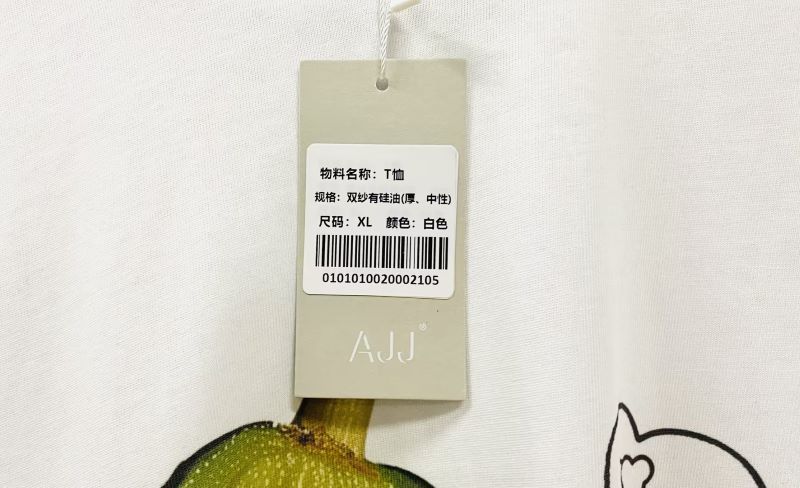What Are Garment Barcodes?
Garment barcodes are codes used to identify products in the clothing industry, and track products at every stage of the supply chain. Typically applied to clothing tags and care labels, these barcodes allow retailers and manufacturers to manage inventory, streamline sales processes, and ensure efficient logistics.
The information encoded in garment barcodes can include the brand name, manufacturer identifier, product identifier, and detailed product information such as size, color, and price, ensuring accurate data management throughout the supply chain.

What Are Garment Barcode Labels?
Garment barcode labels refer to the adhesive stickers applied to clothing tags or external packaging, as well as sewn-in labels and care labels on clothing. As a unique identifier for garments, garment barcodes are often designed along with other garment information and printed on these tags and labels.
The materials for these garment barcode labels can vary widely, including:
● Thermal adhesive stickers
● Coated paper adhesive
● Polyester or high-quality Taffeta
● Satin
When printing these barcode labels, it is essential to ensure that the text is clear and the barcode is readable.

Types of Barcodes Used in Garments
Different types of barcodes are used in the garment industry, each serving specific purposes. Here are the most common ones:
● UPC (Universal Product Code)
UPC is a widely used barcode type, especially in retail. It consists of 12 numerical digits and is mainly used to track items in stores. UPC codes help in quick scanning at the checkout and inventory management.
● EAN (European Article Number)
EAN is similar to UPC but is primarily used in Europe. It comes in 13 digits and is employed for international trade, making it easier to track products globally.
● Code 128
Code 128 is a high-density linear barcode that encodes large amounts of information in a compact format, which makes it ideal for detailed inventory management and logistical purposes.
Its ability to encode letters and numbers provides flexibility in labeling and tracking different garment attributes, such as batch numbers, sizes, and manufacturing dates.
● QR Codes (Quick Response Codes)
QR codes are two-dimensional barcodes that can store a significant amount of data. They are often used for marketing purposes, providing additional information about the product, such as brand stories or promotional offers, accessible via smartphones.
● Manual Barcodes
Manual barcodes can be generated easily using an online barcode generator. These barcodes can be customized to fit specific needs and are useful for smaller businesses that need a simple solution for garment barcode labels.
Benefits of Using Garment Barcodes
Using garment barcodes offers numerous advantages, including:
Efficient Inventory Management: Barcodes streamline the tracking of products from the manufacturer to the retailer, ensuring accurate inventory counts.
Quick and Accurate Scanning: Reduces human error at the point of sale and during stocktaking.
Improved Customer Experience: Faster checkout processes and easy access to product information enhance the shopping experience.
Best Practices for Garment Barcodes
To ensure you get high-quality garment barcodes, follow these best practices:
1. Generating High-Quality Garment Barcodes
Use reliable barcode generators and software that adhere to industry standards. Ensure barcode files are high-resolution, correctly formatted, undistorted, and have sufficient contrast.
2. Printing High-Quality Garment Barcodes
Choose the right printer based on the label material:
● For fabric tags and satin care labels with garment barcodes, use a thermal transfer printer with a rotary cutter for efficient printing and precise cutting.
● For barcode stickers on hang tags and packages, a direct thermal printer is a quick and cost-effective choice.
Additionally, when printing small-sized barcodes, choose a thermal barcode printer with an appropriate DPI resolution.
3. Selecting the Right Barcode Scanners
Use barcode scanners compatible with the types of barcodes you generate. Look for a handheld barcode scanner that offers high accuracy and can read various barcode formats used in the garment industry.
In summary, implementing garment barcodes in your clothing business can significantly enhance efficiency, accuracy, and customer satisfaction.
By understanding the different types of barcodes and their applications, and following best practices for printing and scanning, you can optimize your operations and stay competitive in the market.
Start generating your barcodes today using our free barcode generator and experience the benefits firsthand.
FAQs
1. What information is typically included in a garment barcode?
A garment barcode typically includes the product code, price, size, and sometimes additional details like care instructions or manufacturing date.
This information helps inventory management and provides essential details to customers and retailers.
2. How do I choose the right type of barcodes for the clothing business?
Consider the purpose of the barcode and the information you need to encode.
UPC and EAN are ideal for retail and inventory management, while QR codes are excellent for marketing and providing additional product information.
Use manual barcodes for customized needs with the help of an online barcode generator.




